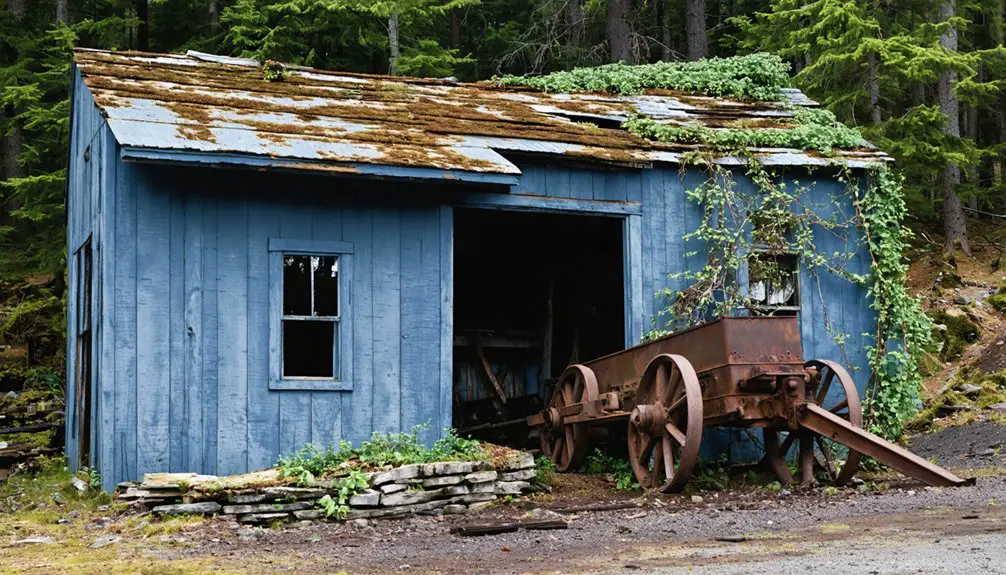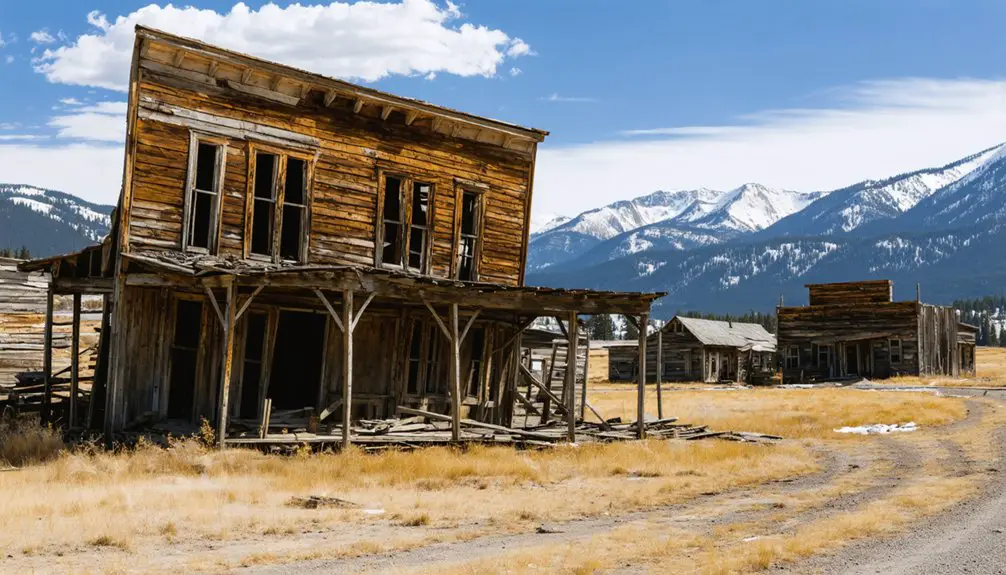You’ll discover Sheridan ghost town nestled in Okanogan County’s rugged terrain at 4,501 feet elevation. This former silver mining boomtown operated from 1900 to 1920, producing high-grade ore worth $75,000 during its peak. Today, you can explore the weathered remnants of its 50-ton flotation mill, three mine adits, and a 300-foot vertical shaft. The town’s mysterious closure and connection to General Philip Sheridan’s controversial legacy hold untold stories in these mountain ruins.
Key Takeaways
- Sheridan was a silver mining town in Okanogan County, Washington, which thrived from the early 1900s until its mysterious abandonment around 1920.
- The town’s silver mines produced high-grade ore yielding up to 300 ounces per ton, processed through a 50-ton flotation mill built in 1918.
- Remnants include three mine adits, a 300-foot vertical shaft, ruins of the flotation mill, and the historic Helphrey store and hotel.
- The ghost town sits at 4,501 feet elevation and requires careful navigation through forest roads while respecting private property boundaries.
- The site features dangerous mine openings and unstable buildings, making exploration hazardous for modern-day visitors.
A Mining Town’s Birth in Silver and Gold
While gold rushes swept through the American West in the mid-1800s, Sheridan’s story began in earnest during the early 1900s in Washington’s mineral-rich Wauconda Mining District.
You’ll find its roots in the region’s first gold discoveries along the Similkameen River in 1859, though early prospectors initially abandoned these claims for Canadian strikes before returning in the 1860s.
The real economic boom kicked off after 1886 when the Chief Moses Reservation opened, giving miners access to valuable underground deposits.
The 1886 opening of Chief Moses Reservation unleashed a mining frenzy as prospectors gained entry to untapped mineral wealth underground.
Using advanced mining techniques for the time, they extracted high-grade ore containing silver, gold, and lead. Today, only two remaining structures stand as testament to this once-thriving mining operation.
Like many mining ventures of the era, the town faced challenges due to financial speculation and investor losses.
The operation grew substantial enough that by 1918, they’d built a 50-ton-per-day flotation mill to process the rich deposits, which included concentrates yielding up to 300 ounces of silver per ton.
Life in Early Sheridan: Beyond the Mines
Beyond the dust and din of mine operations, Sheridan’s residents built a hardscrabble but vibrant community life. You’d find folks gathering at boarding houses and general stores, trading goods or sharing news while stocking up on essentials.
Community gatherings often meant impromptu dances or church services led by traveling preachers, creating bonds that helped everyone weather the daily struggles of frontier living. Like many Plateau tribes, the settlers relied on seasonal hunting and gathering to supplement their food supplies.
Most families worked both the mines and small garden plots, raising vegetables and livestock to sustain themselves through harsh winters. Essential items like salt per bushel cost $12, making trading and bartering a necessity for survival.
When snow blocked the rough wagon trails, you’d rely on your neighbors and carefully stored supplies. While medicine was scarce and winters were brutal, the settlers’ resourcefulness showed in their bartering systems and shared labor, proving there was more to Sheridan than just its silver strikes.
The Phil Sheridan Mine Legacy
You’ll find the Phil Sheridan Mine’s peak operations during the early 1900s to 1920 marked the most prosperous period in Sheridan’s history, with silver production reaching $75,000 in value. The mine’s primary yield of fine-grained silver was extracted from phonolite deposits throughout its operation.
The mine’s technological advancement showed in its 50-ton flotation mill, built in 1918, which could process ore containing up to 300 ounces of silver per ton. The mine shipped remaining ore to the Bodie Mill in 1917.
Today, you can still spot the weathered remains of the mine’s infrastructure, including mill foundations, an old wooden ore chute, and a dangerous 300-foot vertical shaft that serves as a stark reminder of this once-bustling operation.
Mining’s Golden Years
Although Lt. Phil Sheridan never mined a day in his life, his namesake mine became a significant silver producer in early 1900s Washington.
You’ll find the mine’s golden years stretched from 1906 to 1920, when mining techniques evolved from basic extraction to more sophisticated methods, including a 50-ton flotation mill built in 1918. The miners followed N35E adit headings throughout the operation.
During this peak period, the operation yielded impressive silver grades reaching 300 ounces per ton, though economic challenges persisted. Before the mine’s glory days, Sheridan had risen to become General of Army in 1888.
Despite producing $75,000 worth of silver, the mine faced ongoing difficulties with ore processing. An unsuccessful 1914 mill construction forced operators to ship much of their ore elsewhere for treatment.
The mine’s prosperity ultimately proved short-lived, with operations winding down by 1920 as the harsh realities of low-volume deposits and remote location took their toll.
Remnants of Industrial Might
Weathered ruins scattered across Sheridan’s landscape tell the story of its industrial heyday.
You’ll find fascinating industrial archaeology at every turn – from the foundations of the once-bustling 50-ton flotation mill to the remains of the historic Helphrey store and hotel that served the mining community.
The site’s mining technology innovations are still visible in the remnants of an innovative pole chute system that transported ore to the processing facilities.
At 4,501 feet elevation, these ruins showcase the engineering prowess of early 1900s miners who extracted silver-rich ore yielding up to 300 ounces per ton.
While the flotation mill’s 1918 operation proved short-lived, the scattered ruins of processing facilities, mine infrastructure, and community buildings preserve the legacy of Sheridan’s brief but intense industrial period.
Native American Connections
While the ghost town of Sheridan, Washington bears the name of General Philip Sheridan, it’s tied to one of the most controversial military campaigns against Native Americans in the Great Plains.
The land you’re standing on was once home to tribes like the Cheyenne, Kiowa, and Comanche, whose tribal resilience faced devastating challenges during Sheridan’s “Total War” strategy.
You’ll find echoes of this complex history in the surrounding region, where Sheridan’s winter campaigns forced Native Americans onto reservations by destroying their resources, particularly the crucial buffalo herds.
Despite these brutal policies aimed at ending their traditional nomadic lifestyle, cultural legacies of these tribes continue to influence local history, reminding us of their enduring connection to this landscape.
As military governor of Texas, Sheridan first developed his harsh approach to Native American resistance during Reconstruction.
Abandoned Structures and Hidden Stories

Today’s visitors to Sheridan’s silent streets can explore the ghostly remains of the Phil Sheridan mine, a once-bustling operation discovered in 1900.
The abandoned architecture tells hidden narratives through its decaying structures – from the roofless 50-ton flotation mill that once processed high-grade silver ore to the hollow powerhouse that kept operations running.
You’ll find three mine adits and a 300-foot vertical shaft, while scattered worker dwellings reveal stories of daily life during the mine’s 1906-1919 heyday.
Look closely, and you’ll spot evidence of later preservation attempts: plywood patches, repaired roofs, and modified doorways.
The site’s industrial debris, surviving staircases, and building foundations offer glimpses into the past, where miners extracted silver concentrates reaching an impressive 300 ounces per ton before the operation’s mysterious closure around 1920.
Like Liberty’s gold rush history, Sheridan’s silver mining operations represented a significant chapter in Washington’s mining heritage.
Exploring Today’s Ghost Town Remnants
Scattered across Okanogan County’s rugged terrain, Sheridan’s ghost town remnants tell a compelling story of mining ambition and abandonment.
You’ll find the site’s most notable feature, a deteriorating flotation mill that once processed silver ore yielding up to 300 ounces per ton.
While ghost town exploration here requires careful navigation of forest roads and private property boundaries, you’ll discover three mine adits, a 300-foot vertical shaft, and the ruins of the old powerhouse.
Today’s mining site preservation efforts contend with nature’s reclamation as vegetation steadily engulfs the remaining structures.
You’ll need to watch your step around unstable buildings and hazardous mine openings, but the reward is witnessing firsthand the architectural remnants of Washington’s early 20th-century mining technology and community life.
Preserving Washington’s Mining Heritage

The preservation of Washington’s mining heritage extends far beyond protecting physical remnants like Sheridan’s ruins.
You’ll find dedicated organizations like the Black Diamond Historical Society working to document the multicultural stories of mining communities that once thrived throughout the region. While celebrating this rich history, modern mining legislation focuses on balancing resource needs with environmental stewardship.
Today’s preservation efforts reflect both past and future, as you navigate between historical landmarks and contemporary challenges.
Groups like Washington Wild lead coalitions pushing for reformed mining laws that protect wild lands while honoring the industry’s legacy. Through museums, restored buildings, and educational programs, you’re connecting to a mining heritage that spans technological innovation, diverse cultural contributions, and the ongoing dialogue between resource extraction and conservation.
Frequently Asked Questions
What Was the Average Wage of Miners in Sheridan During Peak Operations?
You won’t find exact average miner wage history records from Sheridan, but based on similar Western mining operations of that era, you’d likely have earned between $3-$6 daily.
Were There Any Documented Accidents or Deaths in Sheridan’s Mines?
While there’s no specific record of major accidents in Sheridan’s mines, you’ll find they likely experienced hazards similar to nearby operations where mine safety concerns and accident reports documented numerous fatalities.
How Did Residents Get Supplies During Harsh Winter Months?
You’d rely on stockpiled goods from Guy Helphrey’s store, established supply routes using pack animals, and local hunting to survive winter. Smart residents cached supplies before heavy snows blocked mountain paths.
What Happened to the Mining Equipment When Operations Ceased?
In this legendary ghost town, you’ll find tons of mining equipment was simply abandoned due to sky-high transportation costs. They left everything right where it stood – mill parts, machinery, and all.
Did Any Notable Outlaws or Criminals Ever Pass Through Sheridan?
You won’t find any documented outlaw legends or criminal activities in Sheridan’s history – it was strictly a mining town focused on silver extraction rather than becoming a hideout for notorious characters.
References
- https://www.youtube.com/watch?v=wV7U5UbMKLg
- http://www.ghosttownsusa.com/sheridan.htm
- https://en.wikipedia.org/wiki/Sheridan
- https://www.youtube.com/playlist?list=PLj88QmjC1f05Lly617L81aE2KIG2C1kZg
- http://www.ghosttownsusa.com/okanco.htm
- http://www.ghosttownsusa.com/bttales15.htm
- https://www.mindat.org/loc-22247.html
- https://westernmininghistory.com/mine-detail/10252998/
- https://westernmininghistory.com/mine-detail/10104293/
- https://www.johnhaycenter.org/index.php/our-history/local-history/washington-countys-1st-settlement



